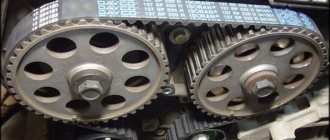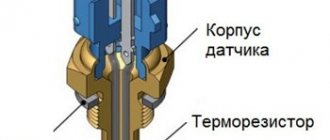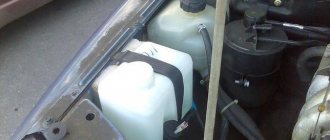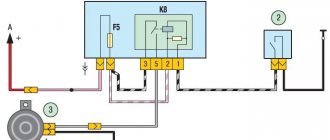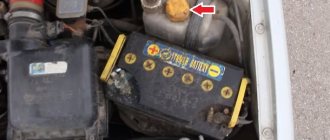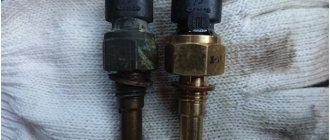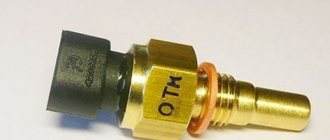Coolant temperature sensor (fan on) and its purpose
A temperature sensor or DTOZh is a part that is included in the engine cooling system and controls the process of warming it up. This element does not display the corresponding temperature values on the instrument panel, since another device is responsible for this action (temperature sensor on the DUTOZH arrow). DTOZH sends a signal to turn on the fan to cool the radiator (at a temperature of 98 to 107 degrees), through which liquid circulates. That is why such a device is often popularly called a fan sensor. However, its correct name is DTOZH or coolant temperature sensor.
In addition to turning on the fan, the DTOZH on the Priora performs another very important function. It consists of adjusting engine operation by changing the composition of the fuel-air mixture and setting the ignition timing. This is achieved by connecting the sensor to the electronic control unit. A corresponding signal about the engine temperature is sent to the ECU from the DTOZH, and depending on the incoming readings, the engine operation is adjusted. It looks something like this:
- When starting the engine cold, the ECU receives a signal that the engine has not warmed up to operating temperature (i.e., cold).
- The control unit makes a decision on preparing fuel assemblies in a certain proportion. To do this, a signal is sent to the idle speed regulator, which opens the XX valve to the appropriate distance (a certain number of steps), which leads to an increase in crankshaft speed. To quickly warm up the engine, more fuel is supplied through the injectors, and the ignition angle is also adjusted.
- When the coolant temperature rises to a certain value, the engine speed is reduced and the mixture composition is adjusted.
If on carburetor cars only liquid temperature sensors are used to display information on the dashboard, and they do not affect the operation of the engine, then on modern injection engines two types of devices are installed. If the coolant sensor is faulty, the engine will most often start and it will run, but the fuel assemblies are prepared according to average values in emergency mode (the computer, if there is no signal from the DTOZH, takes the temperature of the internal combustion engine as 0 degrees). This also turns on the fan, which cools the liquid in the radiator to eliminate the possibility of overheating the engine (since the ECU does not see the actual engine temperature).
Typical signs of a device malfunction are the following:
- unpredictable operation of the cooling fan. If a break occurs in the electrical circuit, which happens due to damage to the supply wire or sensor contacts, the fan will operate continuously
; - floating speed, since the faulty element gives incorrect signals, as a result of which the ECU will strive to adjust the optimal mixture ratio;
- The Check Engine light comes on, indicating an engine malfunction.
It is important not to confuse the coolant temperature sensor on the Priora with the element that is responsible for displaying information about the temperature of the internal combustion engine on the instrument panel. These are two different sensors that have a similar operating principle, but are responsible for performing different functions. If there is a malfunction of the device that displays the engine temperature value on the instrument panel, the CHECK indicator will not light up.
This is interesting! On the Priora, the DTOZH has two contacts, and there is only one sensor per arrow. The operating principle of the devices is the same, and the only difference between them is that on the DTOZh the resistance is measured between the terminals, and on the pointing device - between the body and the contact.
Fan
If the problem lies in the injector or carburetor cooling fan, then you will have to remove it. It is quite possible to repair the unit by replacing the electric motor or impeller.
To remove the valve, perform the following operations:
- Disconnect the negative terminal from the battery;
- Disconnect the wire terminals. One of them is mounted on the fan casing;
- Take a wrench and unscrew a couple of connecting bolts. They fix the vent casing on the left tank;
- Next, unscrew another lower nut holding the device casing;
- Now you will need a socket extension to unscrew the right nut on top that secures the vent housing to the radiator;
- All that remains is to unscrew the fan pressure plate. To do this, remove the pair of left nuts;
- Remove the pressure plate by hand;
- Now remove the fan along with the casing.
You have removed the unit. Now you have a choice - change the entire unit, or try to repair it by replacing the electric motor or impeller if they are damaged.
Replacing the electric motor
- Disconnect the fan motor wire that is held in place by a clamp on the casing.
- The electric motor is held on the casing by three nuts. They all need to be unscrewed.
- Remove the electric motor from the fan housing.
- Be sure to check the condition of the rubber bushings of the electric motor, which will remain on the casing. If cracks or signs of deformation are detected, they must be replaced.
- Check the electric motor for functionality. If it fails, you can purchase a new one and insert it into the old casing.
It is not uncommon that the performance of a radiator fan is impaired due to a deformed impeller. By replacing it, you can restore functionality to the device.
Replacing the impeller
To change the impeller, follow the instructions:
- Pry up the lock washer using a flathead screwdriver. It is located directly in the center of the impeller;
- Lift the washer and remove it;
- In some cases, the impeller is secured to the fan motor with a nut. Therefore, if you have one, unscrew the mount;
- Remove the impeller and assess its condition. If it is worn out or deformed, replace it with a new one;
- Many people, instead of a standard 4-blade impeller, install a more advanced 8-blade impeller.
During reassembly, make sure that the motor pin fits into the longitudinal hole on the impeller, as shown in the figure below.
The principle of operation of the DTOZH on Priora: how the fan switching device functions
The design of the element in question is based on a semiconductor element - a thermistor. When the temperature applied to the thermistor changes, the resistance increases or decreases. Below is a cross-section of the design of the temperature sensor, which will help you understand the principle of its operation.
Such an element is connected to the circuit using two contacts. Changes in temperature change the resistance, and as a result, the voltage in the circuit increases or decreases. The ECU records changes in voltage (drop), and depending on its value, makes appropriate decisions about preparing the mixture and adjusting the ignition. A voltage of up to 5V is supplied to the sensor from the controller through a 2 kOhm resistor, and depending on its fluctuations (drops), the electronic unit determines the engine temperature at the corresponding moment in time.
[Closed] Solved: Radiator fan does not turn on (Page 1 of 2)
To post a reply you must log in or register.
1 Topic from Goodfree 2014-09-09 13:12:37
- Goodfree
- New member
- Inactive
- Registration: 2014-06-18
- Messages: 82Thanks: 8
- Auto: 21102
Topic: Resolved: Radiator fan won't turn on
The bottom line is that the fan does not turn on. Manually (via a button and pulling out the chip from the sensor in the thermostat) - everything works great. What could be the reason? I installed a new sensor, but is there any point in checking the fan relay? (under the cladding on the right). After all, it seems to work, but not through the ECU signal.
2 Reply from igorek 2014-09-09 13:38:47
- igorek
- Brother-in-law
- Inactive
- From: Bryansk region g Starodub
- Registration: 2013-05-05
- Messages: 416Thanks: 191
- Car: VAZ-21102 1.5i-8V Bosch MP7.0H
Re: Resolved: Radiator fan does not turn on
Goodfree, It’s clear that it’s not included, what doesn’t suit you? ileger than the switch but on the verge of boiling away the tasol? there is little information, there are a lot of problems with this malfunction, there is no pressure in the system, the thermostat is not working. When the chip is disconnected, it turns on. This means that the circuit and control of the cooling fan are working properly, look for the cause in the thermostat in the expansion tank cap. It is also possible that the temperature sensor on the instrument panel is lying. misleading.
3 Reply from Aleksandr.21124 2014-09-09 15:24:40
- Aleksandr.21124
- Brother-in-law
- Inactive
- Registration: 2014-08-11
- Messages: 392Thanks: 169
- Car: VAZ 21124
Re: Resolved: Radiator fan does not turn on
The fan relay costs a pretty penny. Under the cladding on the right there are three of them. The problem may be a bad mass. Unscrew and clean all contacts connecting the ground to the body,
behind the left headlight
Weight under the gas pedal on the right bolt (weight of the shield)
4 Reply from Goodfree 2014-09-10 08:02:27
- Goodfree
- New member
- Inactive
- Registration: 2014-06-18
- Messages: 82Thanks: 8
- Auto: 21102
Re: Resolved: Radiator fan does not turn on
The cover is new, the sensor is new. How does the thermostat operate and the fan turn on?
5 Reply from igorek 2014-09-10 11:12:57
- igorek
- Brother-in-law
- Inactive
- From: Bryansk region g Starodub
- Registration: 2013-05-05
- Messages: 416Thanks: 191
- Car: VAZ-21102 1.5i-8V Bosch MP7.0H
Re: Resolved: Radiator fan does not turn on
How does the thermostat operate and the fan turn on? Gudfree, on the stability of the engine temperature and the timely switching on of the cooling fan, let’s put it this way.
6 Reply from Goodfree 2014-09-10 12:12:32 (2014-09-10 12:13:07 edited by Gudfree)
- Goodfree
- New member
- Inactive
- Registration: 2014-06-18
- Messages: 82Thanks: 8
- Auto: 21102
Re: Resolved: Radiator fan does not turn on
Misprinted: How does the operation of the thermostat depend on turning on the fan?
7 Reply from Patroclus 2014-09-10 13:21:21
- Patroclus
- Connoisseur
- Inactive
- From: RUSSIA
- Registration: 2014-07-05
- Messages: 637Thanks: 104
- Car: Lada Priora 2171 Wagon: VESTA
Types of engine temperature sensors: what type is used on Priora
It is important to understand that there are two types of engine temperature sensors. They differ in the principle of operation, and you need to know the operating features in order not to make a mistake when choosing such an element for your car. The following types of DTOZH are distinguished:
- With a negative temperature coefficient
(NTC - negative temperature coefficient) - it works as follows: when the temperature rises, the resistance decreases, and vice versa. - With a positive coefficient
(PTC - positive temperature coefficient) - it has the opposite principle of operation. When the temperature increases, the resistance increases.
The most common types are negative temperature devices. It is these sensors that are used on Priora cars.
When the engine is cold, the maximum resistance of the Priora DTOZH thermistor reaches 100.7 kOhm (this value will be at a temperature of -40 degrees). When the engine warms up, the temperature increases, which means the resistance drops. At a high temperature of +130 degrees, the thermistor resistance is about 70 Ohms. These readings are the operating range. When the engine is cold, the voltage drop in the circuit will be large (drops to 18%). As it warms up, it will increase (up to 90%).
This is interesting! If the engine is cold, then the voltage in the circuit will be about 3.4V, and when it warms up, the value decreases to a minimum (0.15V). It is important to know what type of sensor is used on the car in order to diagnose it and check for serviceability or correct operation.
The dampers don't work
There are situations when the dampers do not work, and their position is not moved by command. In such a situation, look at the condition of the gearmotor. It may have malfunctioned.
The cause of failure of this element may be oxidation of the contacts. To solve the problem, disassemble the casing and clean the contact connections.
Characteristic signs of DTOZ failure on Priora: reasons for increased consumption
The engine temperature sensor or fan activation sensor is one of the main executive elements of the control unit. The malfunction of such a device entails incorrect operation of the engine, and the consequence of such a breakdown “hits the wallet”, because fuel consumption increases significantly. Due to the fact that the DTOZh performs a very important function, measuring the engine temperature and transmitting information to the electronic unit, such a device rarely fails. This means a complete malfunction of the sensor when the Check Engine lights up on the instrument panel and the following error codes are displayed on the on-board computer:
- P0115 - malfunction of the electrical circuit of the DTOZH;
- P0116 - sensor error in the form of values falling outside the permissible range;
- P0117 - low signal level at the DTOZh output (the ECU receives a voltage below 0.14V from the sensor);
- P0118 - increased signal level from DTOZH (output voltage over 4.91V);
- P0119 - unreliable sensor contact. Typically, this error is displayed if the signal from the device is interrupted.
There are the following types of malfunctions of TOZh sensors that are found on Priors:
- Over time, the thermistor begins to show incorrect temperature values, that is, it lies. You can verify this using a multimeter.
- Chafing of wires near the sensor connector, which also leads to its incorrect operation.
- Reduced insulation quality.
Characteristic signs that the element in question is out of order or it is “jamming” are the following manifestations:
- when cold, engine speed drops;
- lack of idling or floating speed;
- unstable operation of the internal combustion engine;
- impossibility of starting the engine when hot (due to DTOZh failure);
- turning on the fan, which is usually accompanied by error P0115.
This is interesting! However, the most common type of DTOZ malfunction on a Priora is when the cooling fans turn on and off for no apparent reason, that is, on a cold engine or if the temperature has not reached the switch-on value.
The consequence of a malfunction of the device is increased fuel consumption to 10-15 liters per 100 km. Operating a car with a faulty DTO is strictly contraindicated. If signs of its malfunction are identified, you should immediately resort to diagnosis or replacement.
Main types of breakdowns
There are two fairly common malfunctions: When the cooling fan of the priors does not turn on at the required moment. The device constantly works, despite the low heating of the internal combustion engine. In the first situation, we can talk about technical breakdowns of the device itself or the failure of a fuse or relay. In the second case, we can most likely say that the cause of this behavior is a faulty temperature sensor.
Identifying the causes of problems and eliminating them The reasons that contribute to the improper operation of the node are:
- Failure of the cooling fan relay. This problem is diagnosed by simply replacing a faulty part with a known working one.
- The second fairly common reason is problems associated with the electric motor itself. If it malfunctions, the rotor stops rotating the impeller. The functionality of the node can be easily checked. Using two wires, it must be directly connected directly to the battery. If the blades do not spin, then the element must be replaced or repaired. To carry out technical work and in-depth diagnostics of the electric motor, it is best to use the diagram.
- The third reason is the temperature sensor. Its breakdowns and improper operation are a fairly common occurrence. Determine the malfunction using the following method. Disconnect the two contact wires from the sensor and connect them together. If the electric drive starts to spin up, this indicates that the sensor has a malfunction.
- Damage or disturbance in the power circuit. In this case, we are talking about a banal wiring break, lack of ground. It is recommended to use a multimeter for diagnostics.
- Malfunction related to the operation of the thermostat.
- Oxidation and damage to the contact chip connected directly to the fan. In this situation, it is necessary to carefully inspect the connector junction and its contacts. If signs of oxidation are detected, clean them.
- The fuse for the Priora cooling fan has blown. Its burnout occurs as a result of high voltage supplied through the on-board network. Replacement is easy and does not cause effort or material costs.
Where is the coolant temperature sensor installed on the Priora?
Many car owners do not know where the element in question is located on Priora until they are faced with the need to diagnose or replace it. In order not to make a mistake and correctly find the coolant temperature sensor on the Priora, below is a photo of its location. It is located between the cylinder head and the thermostat.
Access to it is almost free, but for ease of diagnosis or removal, it is necessary to dismantle the air filter housing. It is important not to confuse this element with the device responsible for displaying temperature readings on the instrument panel. In the design of the Priora cooling system, two temperature sensors are installed: one on the arrow (it is located below), and the second on turning on the fans and transmitting readings to the computer.
Priora. Radiator fan does not turn on
I assure you that the temperature simply does not reach the temperature at which the fan turns on. The reason, for example, is that the coolant pressure does not hold, for example, the tank cap is faulty.
so Yes. But. what is the temp on the Priora? 101g? On my top ten, the vent is on at 101g, but the lid is a dummy (I threw everything out of it. It stands like a boot so that dirt doesn’t fly) and nothing boils. on grant on at 100 g. I did not disassemble the cover. I just twist it a little and that’s it. I can't wait.
TS, I didn’t add water by accident.
tin. I'm familiar with Bosch 7.0. I changed it because the fan was on at 107. Where did the factory raise that much? did 101
so Yes. But. what is the temp on the Priora? 101g? On my top ten, the vent is on at 101g, but the lid is a dummy (I threw everything out of it. It stands like a boot so that dirt doesn’t fly) and nothing boils. on grant on at 100 g. I did not disassemble the cover. I just twist it a little and that’s it. I can't wait.
TS, I didn’t add water by accident.
Yes, I filled it with water, it was about 50/50 water and antifreeze
So it boils earlier than it should. Drain and antifreeze
, and don’t fill it with antifreeze.
How is antifreeze different from antifreeze?
Well, you’re not educated)) the letters are different!
Oga, one is red semi-dry, and the second blue is blue curaçao
Any car owner wants his “iron horse” to work for decades. That is why we listen to the sound of the engine, try to refuel at trusted gas stations, and buy high-quality oils and antifreeze. Although for a novice car enthusiast, choosing many means to improve the performance of a car is a long journey of trial and error. One of the problems may be the choice between antifreeze and antifreeze, because for the uninitiated citizens these two coolants are one and the same. Let's try to find out if they really are that similar.
Definition Antifreeze is the name given to all coolants without exception, regardless of where and when they were produced.
Antifreeze is a type of antifreeze produced in the USSR. Due to the fact that there was no alternative to antifreeze, very soon the name of the brand became a household name, and for a long time other antifreezes that entered the Soviet and then the Russian market were also called that way. In fact, TOSOL is an abbreviation that stands for “technology of organic synthesis of a separate laboratory.”
Composition Antifreeze, like any other coolant, contains ethylene glycol and water. Antifreeze uses additives based on salts of inorganic acids, for example, phosphates, silicates, nitrates and nitrites.
Antifreeze also contains ethylene glycol and water, glycerin, propylene glycol and alcohol. In other words, antifreeze is ethylene glycol (or propylene glycol), water and additives. It is the additives that are especially valuable in the composition, as they increase the anti-corrosion, anti-cavitation, anti-foam capabilities of antifreeze. Antifreeze contains additives based on salts of organic acids.
Performance characteristics Thanks to antifreeze, a protective layer is formed on the metal surface; as a rule, its thickness does not exceed 0.5 mm, but the disadvantage of such protection is low heat transfer. Because of this, fuel consumption increases, and the engine itself wears out faster. Antifreeze loses its cooling ability after 30-40 thousand kilometers. Due to the fact that antifreeze contains inorganic salts such as phosphates and silicates, the formation of gels and sediments is possible, which can lead to clogging of the radiator. At high temperatures, antifreeze works in the system up to a limit of 105 degrees.
Coolant temperature sensor on Priora: technical parameters
The cost of DTOZh on Priora is about 200-400 rubles. Products are produced by different manufacturers, but the most popular are Luzar devices. The coolant temperature sensor on Priora has article number 23.3828.
It comes in a cardboard package along with an O-ring (copper or steel washer), which is important not to forget to put on the thread when installing. Below are the technical parameters of the sensor.
Characteristics of Priora DTOZH
Before installing a new product, you can check it by measuring the resistance value. This will ensure that you have not purchased a defective product. How the replacement is performed is described in detail below.
The main reasons for sensor malfunctions
So, for what reasons on Kalinas and Prioras, and on all VAZs in principle, the controller may not work:
- The first reason is the thermostat not working. This problem is one of the most difficult; when it occurs, the fan will not work correctly. To make sure that the thermostat is working, you will need to touch the lower hose - if it is cold, then the device has really failed. In general, for Kalina, thermostat failure is a fairly common occurrence.
- If the thermostat is working, then it is necessary to diagnose the safety elements. You should also check the condition of the circuits themselves; use a multimeter to do this. The fuse diagram should be indicated on the back of the unit cover. In the case of Kalina, the unit is located under the dashboard, you are interested in fuse element 3, its capacity is 50 amperes. If the fuse is working, then you need to diagnose the fan relay, it is marked with the number 1. If these elements are working, you will have to remove the fan control unit - to do this, move the air duct and, using a 10-mm wrench, unscrew its fastening. There should be two relays on the block, they should be checked.
- It would also be a good idea to climb into the engine compartment and ring the contacts of the fan itself. The problem may be a break, broken wiring, oxidation of contacts, or a burnt-out winding inside the device. Problems with wires and contacts are solved without problems - bad wiring is replaced, and contacts are cleaned. But if the problem lies in the winding, then the device will have to be completely changed.
- The problem may also lie directly in the sensor itself. To start the ventilating unit, you will need to reset the terminals from the device. Diagnosis of the controller is carried out by dismantling the thermostat and placing it in a container with hot water - the thermostat should open at this moment.
- Another reason, which happens quite rarely, is a break in the circuit. This problem can be diagnosed using a multimeter - broken wires must be replaced (the author of the video about diagnosing the regulator with your own hands is Dmitry Maznitsyn).
How to remove and replace the coolant temperature sensor (fan on) on a Priora
The process of replacing the sensor is not complicated, but before implementing it, it is important to know the following: before unscrewing it, you should unscrew the cap of the expansion tank and relieve the pressure in the cooling system. After this, you can begin dismantling work, but it is also important to take into account that after unscrewing the product, antifreeze will flow out of the installation hole. According to the manual, it is recommended to drain antifreeze from the radiator in an amount of at least 1 liter, but practice shows that if you relieve the pressure in the system and quickly replace the device, a small amount of liquid will leak out.
This is interesting! It is important to understand that if you are working on a warm engine, you need to either wait until it cools down or drain the antifreeze so as not to get burned in the process.
The process of replacing DTOZH on Priora is carried out as follows:
- Disconnect the negative terminal from the battery. Why do this? Naturally, no one is going to short-circuit the contacts, and the likelihood that they will close when in contact with metal parts of the engine is extremely low. However, after removing the sensor, antifreeze may get on the chip, and if there is voltage on it (there is none when the ignition is off), the ECU may short out. And therefore, if you do not disconnect the terminal from the battery, then after removing the chip, move it to the side so as to eliminate the possibility of a short circuit. However, to reduce the risk, it is better to disconnect the terminal on the battery.
- To make work easier, it is recommended to remove the air purification filter housing.
- After draining at least 1 liter of liquid from the cooling system (if you decide to go the right way), you need to disconnect the power supply. To do this, you need to pull back the tongue and remove the chip.
- Unscrew the sensor with an open-end wrench to “19”, and if liquid leaks out of the hole, quickly install a new sensor in place, having previously prepared it.
- When installing, do not forget about the copper washer.
- Tighten the sensor with a force of 9.3-15 Nm using a torque wrench.
This completes the process of replacing the fan sensor on the Priora. All that remains is to reset the errors from the BC and make sure that the engine is working properly, as well as the absence of signs that forced you to check and replace the DTOZH.
How to check the sensor yourself?
Checking the fan switch sensor is not difficult.
- If there is a need to diagnose it, you must first find out its functions and operating principle.
- After this, you can test the system by heating the most vulnerable part of the sensor housing. To do this, you need to remove it from the radiator, carefully inspect it, check the contact pads, inspect the wires, and, if necessary, clean it.
- Next, you will need a tool that you can make yourself from a regular light bulb and battery, or use a special tester.
- Bring water to a boil, then connect the tester and sensor contacts and lower its vulnerable side into the water.
- After this, a short circuit should occur. This action will cause the lamp to ignite, or the characteristic sound signal of the tester to appear. If the device shows that the contacts closed before colliding with boiling water, then the sensor is undoubtedly faulty. The author of the video, Mechanical Technician, will tell you how to check the fan switch sensor.
Electric cooling fan (2 fans) Priora Halla with casing
Brand names: LFc – Luzar Fan cooler (fan without casing) LFK – Luzar Fan Kit (fan assembled with casing)
The cooling system fan is an electric motor assembled with an impeller that circulates air flow through the cooling radiator, which ensures better heat removal from the coolant inside the radiator. It is axial (the air flow is directed along the axis of the engine).
Other names are also often used - electric fan, electric fan, cooling motor, radiator motor...
LUZAR produces a wide range of electric fans... more details
Brand names: LFc – Luzar Fan cooler (fan without casing) LFK – Luzar Fan Kit (fan assembled with casing)
The cooling system fan is an electric motor assembled with an impeller that circulates air flow through the cooling radiator, which ensures better heat removal from the coolant inside the radiator. It is axial (the air flow is directed along the axis of the engine).
Other names are also often used - electric fan, electric fan, cooling motor, radiator motor...
LUZAR manufactures a wide range of electric cooling fans for Russian and foreign cars. New models of fans are constantly being developed for the most popular cars in Russia and the CIS countries.
Design of LUZAR cooling fans
It includes two elements - an impeller, which provides the necessary air circulation, and an electric motor, which rotates the impeller.
Impeller (impeller, wing)
The impeller is made of reinforced polypropylene (grodnamid), which guarantees strength and, at the same time, some elasticity of the blades.
The fan impeller is rigidly fixed on the electric motor shaft.
The impeller has blades (vanes) that are specially profiled to provide the most efficient air delivery. The blades can be straight, parabolic (curved) or involute (curved several times).
Electric motor (motor)
An electric cooling fan motor consists of a housing, a shaft with a rotor placed on it, a stator made of permanent magnets fixedly mounted on the housing, sliding contacts (brush assembly), a commutator, spark-extinguishing chokes and two bearings at the ends of the shaft.
The design of the electric motor does not imply maintainability. The electric motor has a service life of more than 5,000 hours, which is equivalent to approximately 8 years of average operation.
A common question is: what is the purpose of spark suppression chokes? They are needed in order to “extinguish” the spark that occurs when the contact of the brushes with the commutator breaks, due to which the brushes and commutator quickly wear out (burn out).
LUZAR: efficient fans
LUZAR places great emphasis on fan efficiency. The volume of air supply largely depends on the correct configuration of the blades. This is why it is so important to select the correct blade profile for a specific electric motor operating at a certain speed.
Creating an impeller profile consists of two stages - calculation and testing. At the design stage, the design department theoretically develops the optimal impeller profile. But at the testing stage, prototypes of impellers are being studied in a wind tunnel. As a result of painstaking work, an impeller with the most optimal shape is created.
LUZAR: modern and reliable fans
Today, LUZAR electric fans are one of the most modern products on the Russian market. In particular, LUZAR fans for Lada cars are unique - the set of technical solutions implemented in these products is not found in competing products. In fact, LUZAR fans for Lada cars are created by analogy with imported fans.
The cooling fans produced fully comply with (or exceed) the requirements of the manufacturers' standards:
- aerodynamic properties
- electrical parameters
All products are certified according to the international quality management system ISO 9001 TUV and have GOST-R certificates of conformity.
In the event of a breakdown, you can easily replace the purchased fan through a retail store - just return it, describing the defect and attaching a warranty card. Warranty for LUZAR cooling motors is 2 years from the date of purchase.
LUZAR: packaging that confirms high quality standards
The excellent quality characteristics of LUZAR fans are confirmed by the presence of convenient, high-quality packaging that protects the product from damage when moving from production to consumer.
LUZAR: pleasant shopping
On our website it is easy to choose a radiator fan specifically for your car: just indicate the product category and make and model of the car. To buy the selected fan, go to the product page and select a purchase method convenient for you in the upper right corner.
The price of LUZAR cooling fans compares favorably with original products, while the quality is not inferior to or superior to the quality of analogues installed at the manufacturing plant.
We will answer all your questions about production, installation, use and points of sale by calling toll-free 8-800-555-8965.
Source: https://luzar.ru/catalogue/elektroventilyatory/elektroventilyatory-okhlazhdeniya/elektroventilyator-okhlazhdeniya-2-ventilyatora-priora-halla-s-kozhukhom-lfk-01270/


